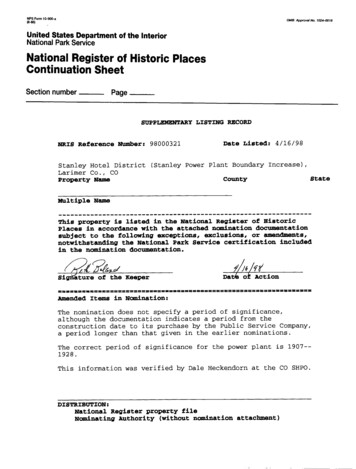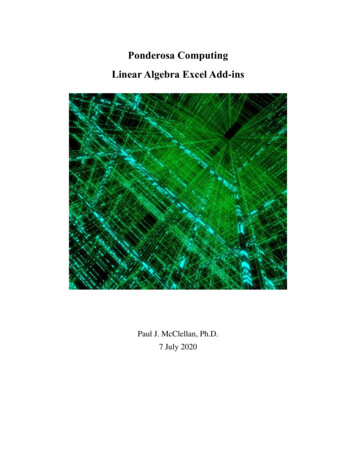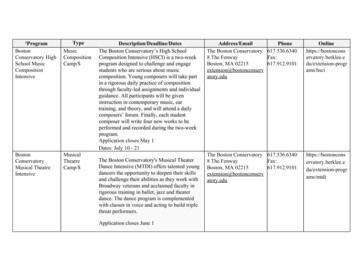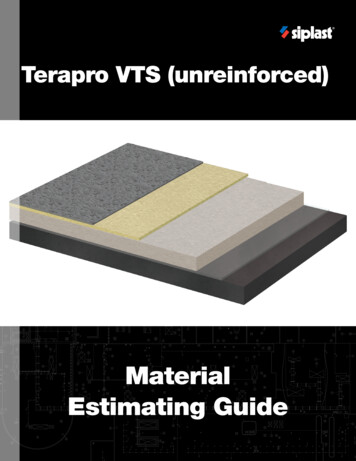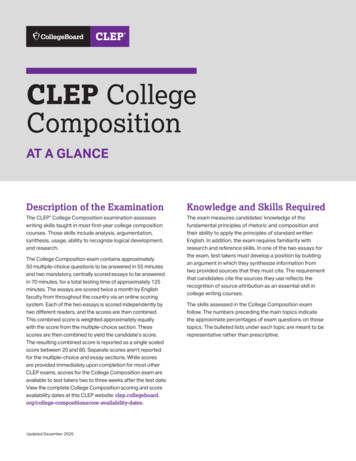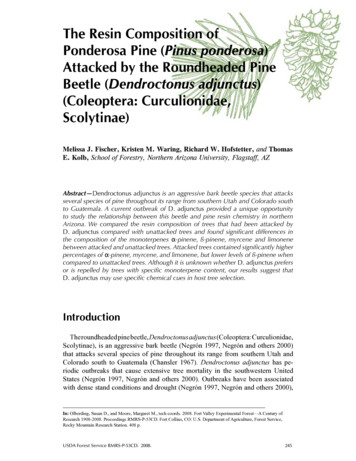
Transcription
The Resin Composition ofPonderosa Pine (Pinus ponderosa)Attacked by the Roundheaded PineBeetle (Dendroctonus adjunctus)(Coleoptera: Curculionidae,Scolytinae)Melissa J. Fischer, Kristen M. Waring, Richard W. Hofstetter, and ThomasE. Kolb, School of Forestry, Northern Arizona University, Flagstaff, AZAbstract—Dendroctonus adjunctus is an aggressive bark beetle species that attacksseveral species of pine throughout its range from southern Utah and Colorado southto Guatemala. A current outbreak of D. adjunctus provided a unique opportunityto study the relationship between this beetle and pine resin chemistry in northernArizona. We compared the resin composition of trees that had been attacked byD. adjunctus compared with unattacked trees and found significant differences inthe composition of the monoterpenes α-pinene, ß-pinene, myrcene and limonenebetween attacked and unattacked trees. Attacked trees contained significantly higherpercentages of α-pinene, myrcene, and limonene, but lower levels of ß-pinene whencompared to unattacked trees. Although it is unknown whether D. adjunctus prefersor is repelled by trees with specific monoterpene content, our results suggest thatD. adjunctus may use specific chemical cues in host tree selection.IntroductionThe roundheaded pine beetle, Dendroctonus adjunctus (Coleoptera: Curculionidae,Scolytinae), is an aggressive bark beetle (Negrón 1997, Negrón and others 2000)that attacks several species of pine throughout its range from southern Utah andColorado south to Guatemala (Chansler 1967). Dendroctonus adjunctus has periodic outbreaks that cause extensive tree mortality in the southwestern UnitedStates (Negrón 1997, Negrón and others 2000). Outbreaks have been associatedwith dense stand conditions and drought (Negrón 1997, Negrón and others 2000),In: Olberding, Susan D., and Moore, Margaret M., tech coords. 2008. Fort Valley Experimental Forest—A Century ofResearch 1908-2008. Proceedings RMRS-P-53CD. Fort Collins, CO: U.S. Department of Agriculture, Forest Service,Rocky Mountain Research Station. 408 p.USDA Forest Service RMRS-P-53CD. 2008.245
which is similar to other Dendroctonus species (Fettig et al. 2007). Host selectionby bark beetles for specific trees within these dense stands remains unclear (Wood1982). Multiple hypotheses have been presented to describe the mechanisms driving bark beetle host selection. These include: 1) locating damaged or diseased treesby the volatile chemicals they emit (Byers 1995, Hofstetter et al. 2008, Wood 1982);2) attraction or repulsion caused by monoterpenes released by trees (Byers 1995,El-Sayed and Byers 2000, Fettig et al. 2007, Hofstetter et al. 2008, Wood 1982);3) attraction to aggregation pheromones released by beetles of the same speciesor to volatiles produced by competing insect species during colonization (Byers1995, Hofstetter et al. 2008, Wood 1982); and 4) bark beetles choose trees for attack randomly (Byers 1995, Wood 1982). Finally, stand conditions may affect hostselection on a larger scale; for example, microclimate and tree vigor vary with standdensity and may partially determine which stands will be attacked (Fettig et al.2007, Miller and Keen 1960, Wood 1982).The resin of conifers contains monoterpenes that have been found to both attractand repel bark beetles (Byers 1995, El-Sayed and Byers 2000, Fettig et al. 2007,Hofstetter et al. 2008, Smith 1966, Sturgeon 1979). Some common monoterpenesfound within resin include α-pinene, ß-pinene, and limonene (Latta et al. 2000).Which monoterpenes repel or attract bark beetles is still uncertain, even among themost well-studied bark beetle species (El-Sayed and Byers 2000). Studies on hostmonoterpene and bark beetle interactions have been inconclusive. For example,lodgepole pines with high levels of limonene were readily attacked and killed byD. ponderosae (Byers 1995); conversely, ponderosa pines with high levels of limonene were not attacked by D. brevicomis (Sturgeon 1979).The overall goal of this project is to gain a better understanding of host selectionbehavior of bark beetles. We use D. adjunctus—ponderosa pine as a model systemto investigate:1. If attacked trees exhibit different size, resin composition, growth rate, crowncharacteristics, or phloem thickness than unattacked trees;2. If beetles cause changes in tree resin composition following attack, and3. If surrounding forest stand density is correlated with beetle attacks in northernArizona.In this paper, we test the hypothesis that attacked trees exhibit a different resincomposition, specifically monoterpenes, than unattacked trees.Materials and MethodsStudy AreaThe study was located near Flagstaff, Arizona, approximately 2.14 km (1.33 miles)north of the Flagstaff Nordic Center. Twenty-five pairs of “attacked” and “unattacked” ponderosa pine trees (50 trees total) were selected in 2007. Paired treeswere similar in diameter at breast height (dbh) (table 1) and location, with the greatest distance being 5.52m (18.11ft) apart. Numerous pitch tubes and the presenceof frass were used to identify successfully attacked trees (Smith 1966, Chansler1967, Nebeker 1993); bark was removed and galleries inspected on a sub-sample246USDA Forest Service RMRS-P-53CD. 2008.
of trees to confirm beetle identification. Trees selected as unattacked had no pitchtubes and/or frass. Attacks by the western pine beetle (D. brevicomis) were alsopresent on site. We differentiated between trees attacked solely by D. adjunctusand D. brevicomis by the size of the pitch tubes on the bole of attacked trees (D.brevicomis attacked trees have smaller pitch tubes) and location of pitch tubes onthe bole (pitch tubes caused by D. brevicomis tend to be higher on the bole thanthose caused by D. adjunctus). We did not select trees that had signs of only D.brevicomis attack.During September 2007, the bark and phloem of each tree was punched at breastheight (1.37m) using a number fifteen 2-cm (0.79 inches) metal punch and a glassvial inserted to collect resin. The glass vials were then removed from the trees andmoved to cold storage prior to composition analysis. Resin collection correspondedto D. adjunctus fall flight; trees that were chosen as pairs were in the process of being attacked when resin was collected. Resin was analyzed for total monoterpenecontent and composition using gas chromatography by the Analytical ChemicalLaboratory at Northern Arizona University. Because some of the trees had no flowing resin at the time of collection and others did not produce enough resin to beanalyzed, only resin from 13 of the attacked trees and 17 of the unattacked treeswere used for this analysis. Due to the fact that we did not have resin for all trees,the resin data was not analyzed as matched pairs, but was instead pooled by attackedor non-attacked. Data were not normally distributed so statistical comparisons weremade using the Kruskal-Wallis test.ResultsNo significant difference was found between the diameters of the paired trees(Table 1).Percentages of α-pinene, ß-pinene, myrcene and limonene were significantly different between attacked and unattacked trees (Table 2, Kruskal-Wallis test, p 0.05),while 3-carene and longifolene were not significantly different between tree pairs(Table 2, Kruskal-Wallis test, p 0.05).Table 1. Matched pairs t-test comparing the diameters of the ponderosa pine trees paired asattacked and unattacked.AttackedNon-attackedMean DBHMean DifferenceSEMp-value29.6 cm (11.65 inches)30.72 cm (12.09 inches)1.12 cm (0.44 inches)0.93920.2447Table 2. Results of Kruskal-Wallis tests comparing percentage monoterpene contentbetween D. adjunctus attacked and unattacked ponderosa pine trees in northern Arizona.Chi-SquaredfAsymp. 4.20610.0401.73810.187USDA Forest Service RMRS-P-53CD. 2008.247
Figure 1. Average percent of individual monoterpenes in the total monoterpene content ofD. adjunctus attacked and unattacked ponderosa pine trees in northern Arizona. Errorbars represent 95 percent confidence intervals and asterisks signify significant differences(p 0.05; see text for details).Attacked trees contained significantly higher percentages of α-pinene, myrcene,and limonene, but lower levels of ß-pinene when compared to unattacked trees(Figure 1).Although ß-pinene showed a significant difference between attacked and unattacked trees, high levels of ß-pinene were not found in all of the unattacked trees(Figure 2b). Amount of individual monoterpenes as a percentage of the total monoterpene content varied between attacked and unattacked trees for most analyzedmonoterpenes (Figure 2).DiscussionOur study demonstrated that there are significant differences in monoterpenecomposition between bark beetle attacked and non-attacked trees. Contrary to paststudies on other bark beetle species that found high levels of myrcene (Byers 1995)and limonene (Sturgeon 1979) in unattacked trees, half of our unattacked treesshowed high levels of ß-pinene. Differences between the monoterpene composition of unattacked trees in our study compared with previous studies (Smith 1966,Byers 1995, Sturgeon 1979) may be explained by geographic variation (Byers 1995,Hofstetter et al. 2008). Monoterpenes vary widely between geographic regions andamong trees within local populations of ponderosa pine (Smith 1966, Latta et al.2000, Thoss and Byers 2006, Hofstetter et al. 2008). Thus, those monoterpenesshown to be important in host selection for a bark beetle species in one geographicregion might not be attractive to populations of the same species in another region(Byers 1995, Hofstetter et al. 2008).248USDA Forest Service RMRS-P-53CD. 2008.
Figure 2. Individual monoterpene content as a percent of total monoterpene found inD. adjunctus attacked and unattacked ponderosa pine trees in northern Arizona: a.α-pinene; b. β-pinene; c. myrcene; d. 3-carene; e. limonene and f. longifolene.Genetic differences among beetles from different geographic regions may reflectthe variation in the monoterpene composition of their host as well (Byers 1995,Hofstetter et al. 2008). Bark beetle populations may be adapted to monoterpeneratios specific to geographic region (Byers 1995, Hofstetter et al. 2008). As a result, total monoterpene composition or certain ratios may be more important indetermining host repellency than individual monoterpenes such as limonene (Byers1995).USDA Forest Service RMRS-P-53CD. 2008.249
Attraction of D. adjunctus to host tree compounds, including monoterpenes, hasnot been previously studied (Byers 1995). Therefore, whether D. adjunctus prefers or is repelled by trees with specific monoterpene composition is not known.Our results suggest that D. adjunctus, or at least this particular local population ofD. adjunctus, may be attracted to or repelled from certain host tree compounds.Additional research has yet to be completed, including a baiting study to ensurethat the resin composition of the trees analyzed was not induced by D. adjunctusattack.AcknowledgmentsThis research was supported, in part, by McIntire-Stennis appropriations to NAUand the State of Arizona. Resin analyses were paid for by U.S.D.A. CooperativeAgreement 06-CA-11330129-046 (to R.W.H) and completed by the AnalyticalChemical Laboratory at Northern Arizona University. Barbara Bentz, Joel McMillinand José Negrón provided beneficial reviews of the draft manuscript.ReferencesByers, John A. 1995. Host chemistry affecting colonization in bark beetles. In: Carde, T.;Bell, William J. Chemical ecology of insects 2. New York: Chapman & Hall: 154-213.Chansler, John F. 1967. Biology and life history of Dendroctonus adjunctus (Coleoptera:Scolytidae). Annals of the Entomological Society of America. 60: 760-767.Christiansen, Erik; Waring, Richard H.; Berryman, Alan A. 1987. Resistance of conifersto bark beetle attack: Searching for general relationships. Forest Ecology andManagement. 22(1-2): 89-106.El-Sayed, Ashraf M.; Byers, John A. 2000. Inhibitory effect of monoterpenes on responseof Pityogenes bidentatus to aggregation pheromone released by piezoelectric sprayerfor precision release of semiochemicals. Journal of Chemical Ecology. 26: 8.Fettig, Christopher J.; Klepzig, Kier D.; Billings, Ronald F.; Munson, A. Steven;Nebeker, T. Evan; Negrón, José F.; Nowak, John T. 2007. The effectiveness ofvegetation management practices for prevention and control of bark beetle infestationsin coniferous forests of the western and southern United States. Forest Ecology andManagement. 238: 24-53.Hofstetter R. W.; Chen, Z.; Gaylord, M. L.; McMillin, J. D.; Wagner, M. R. 2008.Synergistic effects of a-pinene and exo-brevicomin on pine bark beetles and associatedinsects of Arizona. Journal of Applied Entomology. 132: 387-397.Miller, J. M.; Keen, F. P. 1960. Biology and control of the western pine beetle. Asummary of the first fifty years of research. Washington D.C.: U.S. Department ofAgriculture; 381 p.Nebeker, T. E.; Hodges, J. D.; Blanche, C. A. 1993. Host response to bark beetle andpathogen colonization. In: Scholwalter, T. D.; Filip, G. M., eds. Beetle-pathogeninteractions in conifer forests. New York: Academic Press: 157-169.250USDA Forest Service RMRS-P-53CD. 2008.
Negrón, José. 1997. Estimating probabilities of infestation and extent of damage bythe roundheaded pine beetle in ponderosa pine in the Sacramento Mountains, NewMexico. Canadian Journal of Forest Research. 27: 1936-1945.Negrón, José; Wilson, Jill L.; Anhold, John A. 2000. Stand conditions associated withroundheaded pine beetle (Coleoptera: Scolytidae) infestations in Arizona and Utah.Environmental Entomology. 29(1): 20-7.Smith, R. H. 1966. The monoterpene composition of ponderosa pine xylem resin and ofD. brevicomis pitch tubes. Forest Science. 12: 1.Smith, R. H. 1975. Formula for describing the effect of insect and host tree factorson resistance to western pine beetle attack. Journal of Economic Entomology. 68:841-844.Sturgeon, Kareen B. 1979. Monoterpene variation in ponderosa pine xylem resin relatedto western pine beetle predation. Evolution. 33: 803-814.Thoss, Vera; Byers, John A. 2006. Monoterpene chemodiversity of ponderosa pine inrelation to herbivory and bark beetle colonization. Chemoecology. 16: 51-58.Wood, D. L. 1982. The role of pheromones, kairomones, and allomones in the hostselection and colonization behavior of bark beetles. Annual Review of Entomology.27: 411-446.The content of this paper reflects the views of the author(s), who are responsible for thefacts and accuracy of the information presented herein.USDA Forest Service RMRS-P-53CD. 2008.251
Rocky Mountain Research Station. 408 p. The Resin Composition of Ponderosa Pine . Kristen M. Waring, Richard W. Hofstetter, and Thomas E. Kolb, School of Forestry, Northern Arizona University, Flagstaff, AZ Abstract . to D. adjunctus fall flight; trees that were chosen as pairs were in the process of be-



